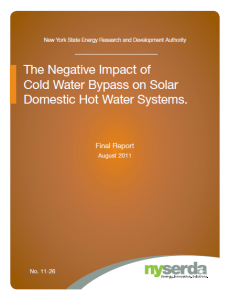 A solar domestic hot water (SDHW) system is designed to save fossil fuels or electricity by reducing the energy used by conventional domestic hot water (DHW) appliances. System efficiency is dependent upon the assumption that the vast majority of incoming cold water will be preheated by the SDHW system and will not enter the DHW system in any other way. When incoming water is diverted from the preheat tanks, thermal energy captured by the solar collectors is not distributed to the DHW system, and the conventional appliance has to provide more heat and consume more fuel.
A solar domestic hot water (SDHW) system is designed to save fossil fuels or electricity by reducing the energy used by conventional domestic hot water (DHW) appliances. System efficiency is dependent upon the assumption that the vast majority of incoming cold water will be preheated by the SDHW system and will not enter the DHW system in any other way. When incoming water is diverted from the preheat tanks, thermal energy captured by the solar collectors is not distributed to the DHW system, and the conventional appliance has to provide more heat and consume more fuel.
This paper presents an analysis of the internal dynamics of the flow of thermal energy and hot water through a solar domestic hot water (SDHW) system installed in a multifamily high-rise apartment building in the Bronx. The purpose of this study was to: (1) determine why this specific SDHW system’s thermal performance is demonstrably lower than predicted; (2) assess the effects of a recirculation pump and a mixing valve on the output of SDHW systems in general; (3) identify a potentially endemic problem in multifamily high-rise buildings that negatively impacts the performance of SDHW systems and other building systems that employ preheated water in their operation; and (4) identify diagnostic techniques and potential solutions to this problem.
Although the solar thermal system functions correctly and harnesses heat energy during the day by storing it in domestic hot water preheat tanks, it has been observed that the majority of this hot water is not transferred to the building DHW system, resulting in sub-optimal performance of the SDHW system. Monitoring of system flows and temperatures demonstrate that such performance degradation is caused by cold water bypass: cold water enters the DHW system by means that circumvent the solar preheat tanks, reducing the net flow of water through these tanks and impeding the distribution of the stored solar energy.
As defined, cold water bypass has two components; mixing valve bypass, which is intentional to the original design of the system, and rogue bypass, which is unintentional and derives from a source of cold water that is not readily identifiable.
Rogue bypass accounts for 82% of the water entering the DHW system – this means that the water drawn through the preheat tanks is reduced to 18% of what was assumed in its design. This reduction of flow was found to result in a 45% average reduction in savings, both in energy and dollar terms. This means it would take nearly twice the time for the system owner to recoup the initial investment. Mixing valve bypass alone has a negligible effect on system performance, and in the absence of rogue bypass is necessary for safe operation of the system. When combined, rogue bypass and mixing valve bypass represent an even greater percentage of the water not flowing through the preheat tanks, and the net resulting system performance degradation increases along with the greater percentage of cold water bypass.
Future studies will investigate the hypothesis that this phenomenon is prevalent among other high-rise buildings and may have significant implications to the design and installation of SDHW systems, cogeneration systems, and other processes using preheat strategy.